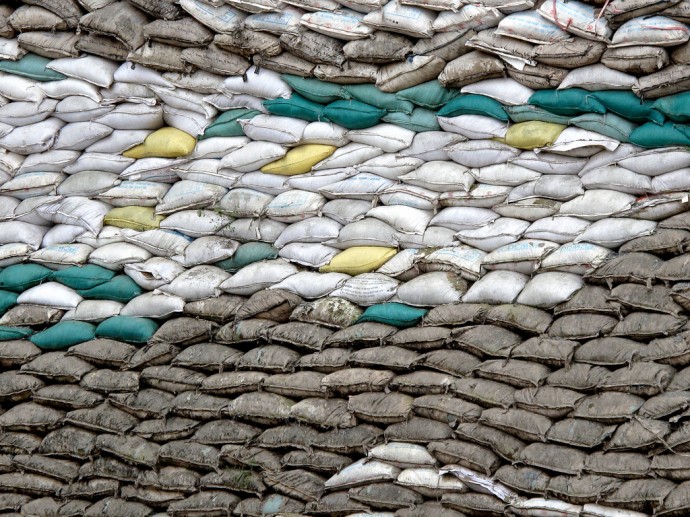Reactions #262. Mammoth: Appeal

Quaderns #262
Let us suppose for a moment that the “Parainfrastructures” which Quaderns #262 concerns itself with are a class of things, that object-parodying helium balloons hovering around Heathrow Airport to block its expansion, inflatable “instant cities” powered by air compressors, “geodesic domes, parachutes, spray-foam dwellings, zomes, space frames”, “indoor built and ephemeral complexes” colonizing the open floor plans of abandoned airports, and architectural systems of “air control” can be read as a category of architectural objects called “parainfrastructures”. Even though we will be supposing in error—because “Parainfrastructures” never seeks to delineate its subject matter by so crude a means as a definition—this seems a productive error, because it permits us to see a pervasive weirdness.
This weirdness, in the context of architectural critique, is that parainfrastructures paradoxically gain their strength and appeal from having been designed with a certain disregard for aesthetics. Parainfrastructures are constructed out of the banal materials of twentieth-century industrial innovation like synthetic fabrics, geotextiles, and industrial plastics, not the refined and expensive finishes of high-corporate architecture. Structurally, they depend on ties, straps, bendable rods, and air compressors—temporary, flexible, contingent engineering.
Here, these architectural parainfrastructures have kinship with the new kind of infrastructures the opening editorial, John May’s “Infrastructuralism”, and Javier Garcia-German’s “Infrastructure and Time” imply the need for through their critiques of “an infrastructural model at risk of quickly becoming obsolete” [1]:
“Against this static view, more recently infrastructures have been conceptualised as open systems. If during modernity they were designed as isolated, highly specialised systems that remained static in the face of external contingencies, they have now progressed towards being viewed as interactive systems, with a specific spatial organisation (structure) and behaviour (functioning) continually undergoing adaptation to changing surrounding circumstances.” [2]
The responsiveness and adaptivity of these new alternative infrastructures can be contrasted with the qualities of traditional hard infrastructure in the same way that the flexibility and contingency of the engineering of parainfrastructures can be contrasted with the qualities of traditional building engineering.
The appeal of parainfrastructures (both as a class of architectural objects and as an alternative format for infrastructures) is not only aesthetic; it is also organizational, in that parainfrastructures operate primarily as organizational architectures. In fact, their aesthetic qualities are generated by their organizational qualities—the Instant City derives its shape from the interior activities it hosts, rather than conforming interior activities to its shape.
Oddly, this points to a way that parainfrastructures are more like the heroic modern infrastructures of the twentieth century than they are different: they all gain their aesthetic power from the blunt translation of organizational qualities into material structure [3]. Just as the appeal of Roger Sauquet’s proposal for “Emergency Solutions” comes from envisioning the interiors of abandoned airports continually being restructured by the programmatic dictates of a temporary and provisional architecture of “internal versatility”, much of the aesthetic pleasure and power of hard infrastructure—like a cloverleaf ramp looping overhead, or a dam towering over river—comes from the direct link between how the infrastructure is structured and how it organizes. Altering the aesthetics of an infrastructure without considering its organizational performance at best fails to tap into this fundamental source of sublimity, and at worst begins to divorce the infrastructure being designed from the very qualities that make it so aesthetically powerful.
Thus while the deployment of parainfrastructures and hard infrastructures responds to vastly different conditions and generates wildly divergent potentials, in both cases the architect—if she wants to harness their full aesthetic power—must learn to subordinate aesthetics.
[1]“Editorial: Parainfrastructures” in Quaderns 262: “Parainfrastructure”, 2011, p. 1.
[2]Javier Garcia-German, “Infrastructure and Time: Apropros Anticipation and Adaptation” in Quaderns 262: “Parainfrastructure”, 2011, p. 49.
[3]Note that this is not to say that parainfrastructures are more like heroic modern infrastructures than they are different — “Parainfrastructures” makes a strong case that they are quite different — only that in this way they are more similar than different. This is useful because it means that lessons learned about the design of one category of infrastructures are also relevant to the design of the other.

